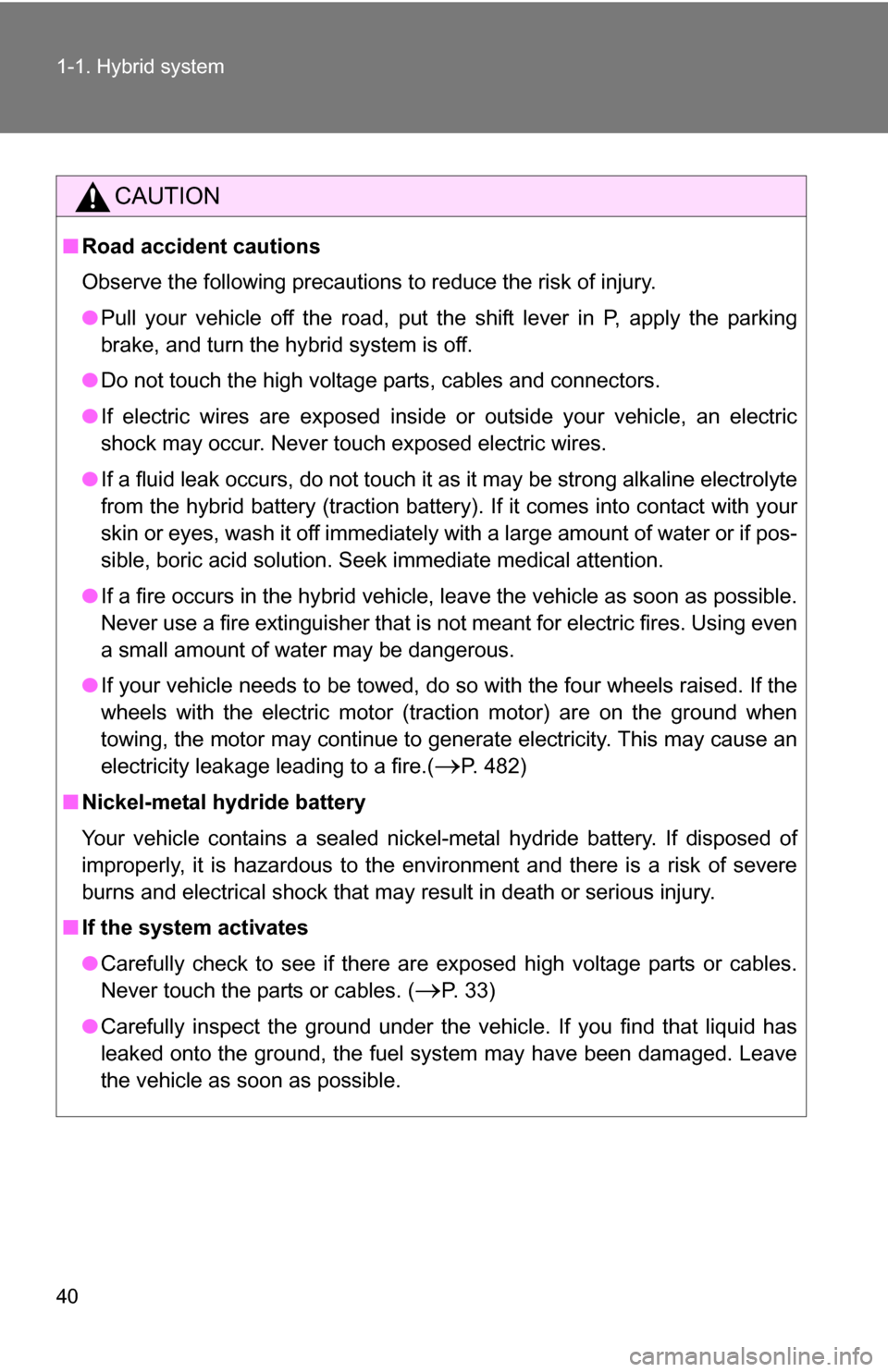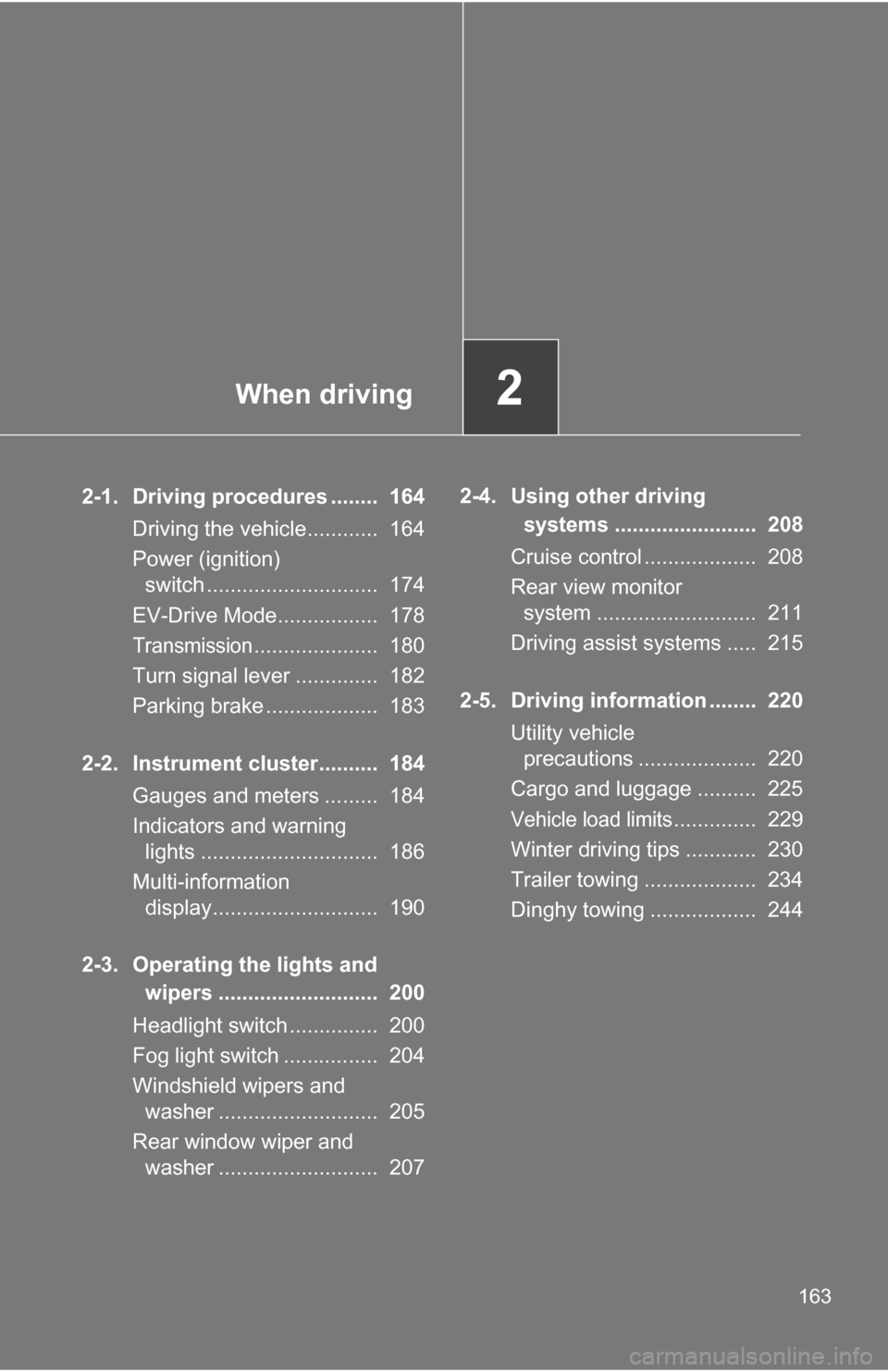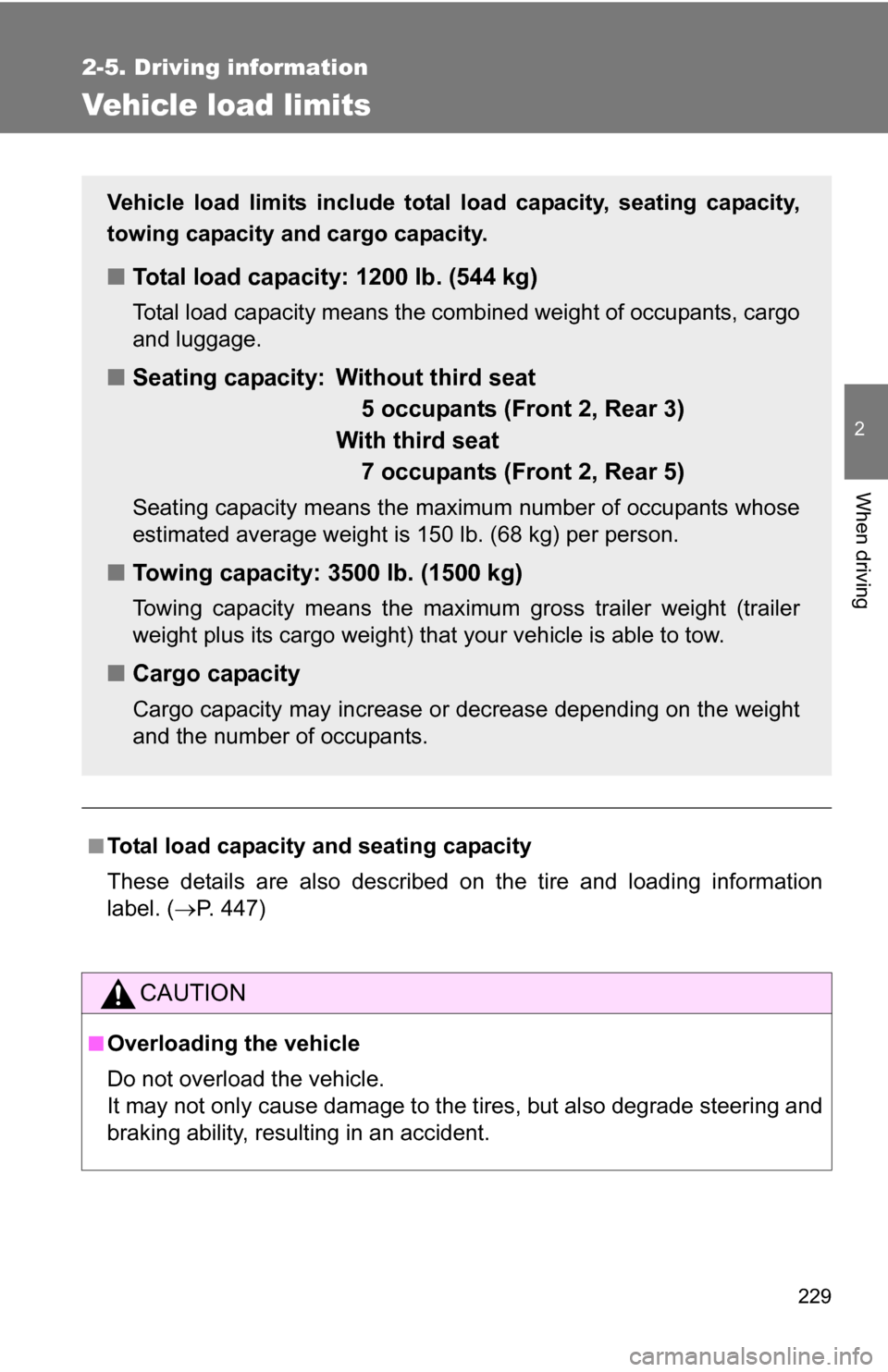Page 3 of 580

1
2
3
4
5
6
7
3
2-3. Operating the lights and wipers .............................. 200
Headlight switch .................. 200
Fog light switch ................... 204
Windshield wipers and washer .............................. 205
Rear window wiper and washer .............................. 207
2-4. Using other driving systems ........................... 208
Cruise control ...................... 208
Rear view monitor system .............................. 211
Driving assist systems ........ 215
2-5. Driving information ........... 220 Utility vehicle precautions ....................... 220
Cargo and luggage ............. 225
Vehicle load limits................. 229
Winter driving tips ............... 230
Trailer towing ...................... 234
Dinghy towing ..................... 244 3-1. Using the air
conditioning system
and defogger .................. 248
Front manual air conditioning system.......... 248
Front automatic air conditioning system.......... 253
Rear manual air conditioning system.......... 261
Rear automatic air conditioning system.......... 264
Rear window and outside rear view mirror
defoggers ......................... 267
Windshield wiper de-icer .............................. 269
Using the steering wheel climate remote control
switches ........................... 270
3-2. Using the audio system ............................. 271
Audio system (without navigation system) ........... 271
Using the radio ................... 274
Using the CD player ........... 280
Playing back MP3 and WMA discs ....................... 287
Optimal use of the audio system .............................. 294
Using the AUX adapter....... 297
Using the steering wheel audio switches.................. 299
3Interior features
Page 40 of 580

40 1-1. Hybrid system
CAUTION
■Road accident cautions
Observe the following precautions to reduce the risk of injury.
●Pull your vehicle off the road, put the shift lever in P, apply the parking
brake, and turn the hybrid system is off.
● Do not touch the high voltage parts, cables and connectors.
● If electric wires are exposed inside or outside your vehicle, an electric
shock may occur. Never touch exposed electric wires.
● If a fluid leak occurs, do not touch it as it may be strong alkaline electrolyte
from the hybrid battery (traction battery). If it comes into contact with your
skin or eyes, wash it off immediately with a large amount of water or if pos-
sible, boric acid solution. Seek immediate medical attention.
● If a fire occurs in the hybrid vehicle, leave the vehicle as soon as possible.
Never use a fire extinguisher that is not meant for electric fires. Using even
a small amount of water may be dangerous.
● If your vehicle needs to be towed, do so with the four wheels raised. If the
wheels with the electric motor (traction motor) are on the ground when
towing, the motor may continue to generate electricity. This may cause an
electricity leakage leading to a fire.(
P. 482)
■ Nickel-metal hydride battery
Your vehicle contains a sealed nickel- metal hydride battery. If disposed of
improperly, it is hazardous to the environment and there is a risk of severe
burns and electrical shock that may result in death or serious injury.
■ If the system activates
●Carefully check to see if there are exposed high voltage parts or cables.
Never touch the parts or cables. (
P. 33)
● Carefully inspect the ground under the vehicle. If you find that liquid has
leaked onto the ground, the fuel system may have been damaged. Leave
the vehicle as soon as possible.
Page 163 of 580

When driving2
163
2-1. Driving procedures ........ 164Driving the vehicle............ 164
Power (ignition) switch ............................. 174
EV-Drive Mode................. 178
Transmission..................... 180
Turn signal lever .............. 182
Parking brake ................... 183
2-2. Instrument cluster.......... 184 Gauges and meters ......... 184
Indicators and warning lights .............................. 186
Multi-information display............................ 190
2-3. Operating the lights and wipers ........................... 200
Headlight switch ............... 200
Fog light switch ................ 204
Windshield wipers and washer ........................... 205
Rear window wiper and washer ........................... 207 2-4. Using other driving
systems ........................ 208
Cruise control ................... 208
Rear view monitor system ........................... 211
Driving assist systems ..... 215
2-5. Driving information ........ 220 Utility vehicle precautions .................... 220
Cargo and luggage .......... 225
Vehicle load limits.............. 229
Winter driving tips ............ 230
Trailer towing ................... 234
Dinghy towing .................. 244
Page 226 of 580

226 2-5. Driving information
(6) If your vehicle will be towing a trailer, load from your trailer will be
transferred to your vehicle. Consult this manual to determine how
this reduces the available cargo and luggage load capacity of your
vehicle.
Example on your vehicle
Cargo capacity
Total load capacity
When 2 people with the combined weight of 366 lb. (166 kg) are
riding in your vehicle, which has a total load capacity of 1200 lb. (544
kg), the available amount of cargo and luggage load capacity will be
as follows:
1200 lb. - 366 lb. = 834 lb. (544 kg -166 kg = 378 kg)
In this condition, if 3 more pa ssengers with the combined weight of
388 lb. (176 kg) get on , the available cargo and luggage load will be
reduced as follows:
834 lb. - 388 lb. = 446 lb. (378 kg - 176 kg = 202 kg)
As shown in the above example, if the number of occupants
increases, the cargo and luggage load will be reduced by an amount
that equals the increased weight du e to the additional occupants. In
other words, if an increase in the number of occupants causes an
excess of the total load capacity (combined weight of occupants plus
cargo and luggage load), you must reduce the cargo and luggage on
your vehicle.
Page 229 of 580

229
2-5. Driving information
2
When driving
Vehicle load limits
■Total load capacity and seating capacity
These details are also described on the tire and loading information
label. (P. 447)
CAUTION
■Overloading the vehicle
Do not overload the vehicle.
It may not only cause damage to the ti res, but also degrade steering and
braking ability, resulting in an accident.
Vehicle load limits include total load capacity, seating capacity,
towing capacity and cargo capacity.
■ Total load capacity: 1200 lb. (544 kg)
Total load capacity means the combined weight of occupants, cargo
and luggage.
■Seating capacity: Without third seat
5 occupants (Front 2, Rear 3)
With third seat
7 occupants (Front 2, Rear 5)
Seating capacity means the maxi mum number of occupants whose
estimated average weight is 150 lb. (68 kg) per person.
■ Towing capacity: 3500 lb. (1500 kg)
Towing capacity means the maximu m gross trailer weight (trailer
weight plus its cargo weight) that your vehicle is able to tow.
■Cargo capacity
Cargo capacity may increase or decrease depending on the weight
and the number of occupants.
Page 234 of 580
234
2-5. Driving information
Trailer towing
Your vehicle is designed primarily as a passenger carrying vehicle.
Towing a trailer will have an adverse effect on handling, perfor-
mance, braking, durability, and fuel consumption. For your safety
and the safety of others , do not overload the vehicle or trailer.
To tow a trailer safely, use extreme care and drive the vehicle in
accordance with the tra iler's characteristics and operating condi-
tions.
The vehicle stability and braking performance are affected by trailer
stability, brake setting and performance, and the hitch.
Toyota warranties do not apply to damage or malfunction caused by
towing a trailer for commercial purposes.
Contact your Toyota dealer for fu rther information about additional
requirements such as a towing kits, etc.
Page 235 of 580
235
2-5. Driving information
2
When driving
Weight limits
Confirm that the gross trailer weig ht, gross vehicle weight, gross axle
weight and trailer tongue load are all within the limits.
Towing capacity: 3500 lb. (1500 kg)
● The gross trailer weight must never exceed towing capacity
described in the table above.
●The gross vehicle weight must
never exceed the GVWR indi-
cated the Certification Label.
● The gross axle weight on each
axle must never exceed the
GAWR indicated the Certifica-
tion Label.
Page 236 of 580

236 2-5. Driving information
Towing related term
Towing related termMeaning
GVWR (Gross Vehicle
Weight Rating) The maximum allowable gross vehicle
weight. The gross vehicle weight is the
total weight of the vehicle. When towing
a trailer, it is the sum of the vehicle
weight (including the occupants, cargo
and any optional equipment installed on
the vehicle) and the tongue load.
GAWR (Gross Axle Weight
Rating) The maximum allowable gross axle
weight. The gross axle weight is the load
placed on each axle (front and rear).
Gross trailer weight The sum of the trailer weight and the
weight of the cargo in the trailer
Towing capacity The maximum allowable gross trailer
weight. Towing capacity is calculated
considering the base vehicle with neces-
sary vehicle equipment and occupants.
Additional optional equipment, passen-
gers and cargo in the vehicle will reduce
the towing capacity, gross trailer weight
include the trailer, cargo and necessary
equipment for towing.
Tongue load The load placed on the trailer hitch ball